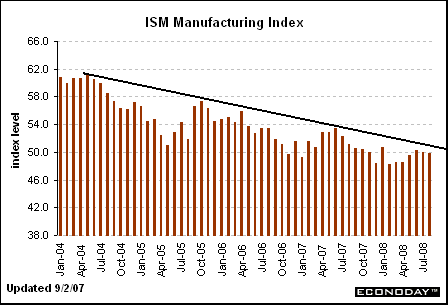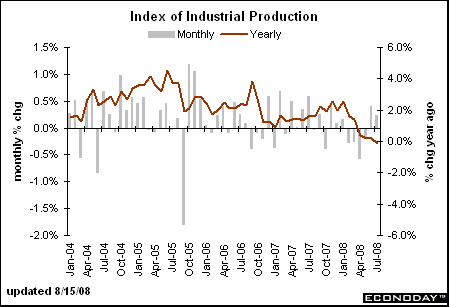The committee places particular emphasis on two monthly measures of activity across the entire economy: (1) personal income less transfer payments, in real terms and (2) employment. In addition, we refer to two indicators with coverage primarily of manufacturing and goods: (3) industrial production and (4) the volume of sales of the manufacturing and wholesale-retail sectors adjusted for price changes. We also look at monthly estimates of real GDP such as those prepared by Macroeconomic Advisers (see http://www.macroadvisers.com). Although these indicators are the most important measures considered by the NBER in developing its business cycle chronology, there is no fixed rule about which other measures contribute information to the process.
The above paragraph outlines some of the economic trends the NBER looks for when dating a recession. In other words, the NBER looks at manufacturing to get an idea of where the economy is. The logic behind this is straightforward. If an economy is expanding, it makes more "stuff". If an economy is contracting, it makes less stuff.
That's why today's ISM news is important:
An index of manufacturing in the U.S. fell in August for the first time in three months as companies slowed production and cut payrolls in the face of weakening consumer spending.
The Institute for Supply Management's factory index fell to 49.9 last month from 50.0 the prior month, the Tempe, Arizona- based group reported today. The ISM gauge has hovered near 50, the dividing line between expansion and contraction, for the past year.
Manufacturers are receiving fewer orders as tumbling home prices and expensive gasoline weigh on consumer demand. Surging exports are keeping factories from stumbling as the broader economy slows.
``Manufacturing has been rather flat,'' said Norbert Ore, chairman of the ISM survey, in a conference call from Atlanta. ``It's a consistent story of slow contraction that's been going on for quite some time.''
The ISM index was projected to remain unchanged at 50, according to the median of 72 economists' forecasts in a Bloomberg News survey. Estimates ranged from 48.5 to 52.
First, let's pull back the lens a bit to see where we are in the overall cycle.

The ISM number has been dropping for the last 4 years to its current level of around 50. 50 is the line used in the survey to distinguish between a manufacturing expansion (a reading over 50) and a manufacturing contracting (a reading under 50).
Let's tie today's number into a larger data set -- industrial production.

The year over year percentage change in industrial production is near 0% now and has been dropping since the beginning of the year. Today's number does not help that trend very much.
About the only good news from the manufacturing side has been exports, but with Japan and Europe staring at slowdowns that story may come under pressure now as well.
This is another data point that points to lackluster economic growth for the next quarter or two.